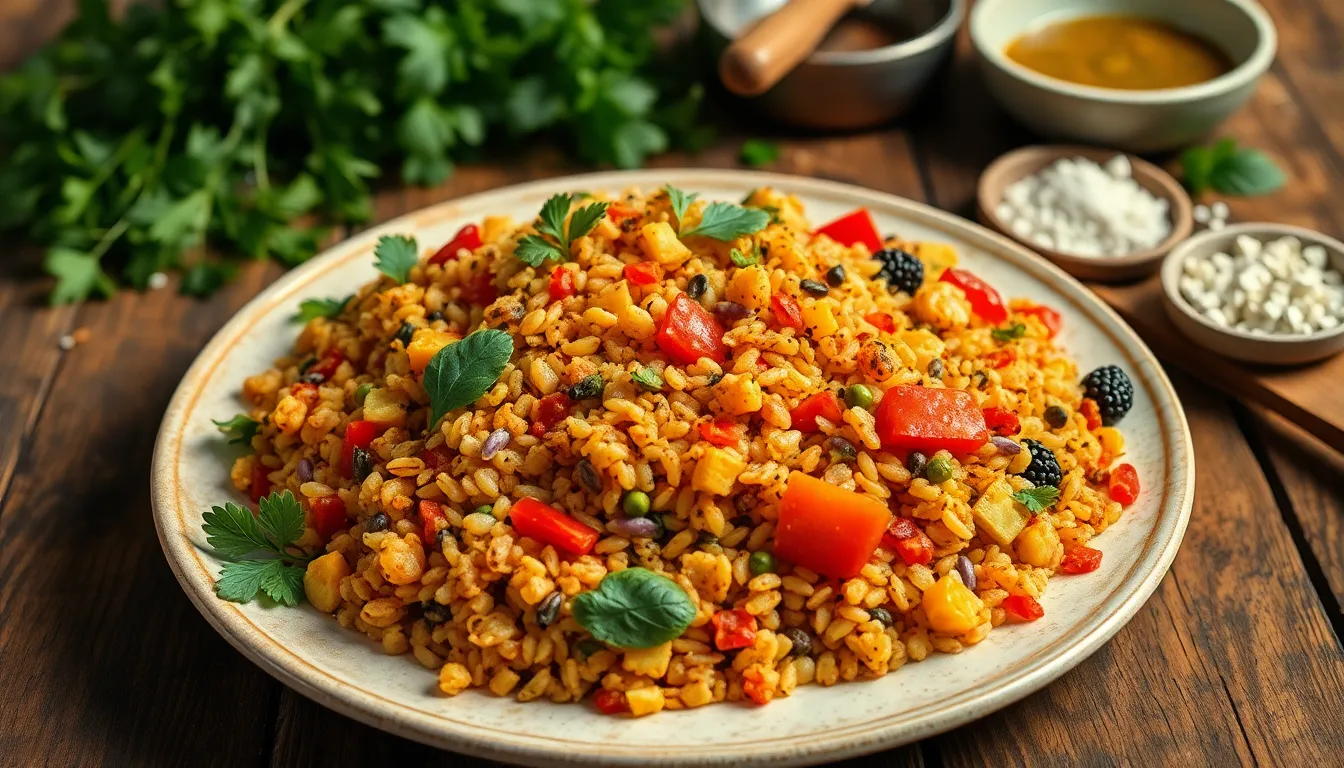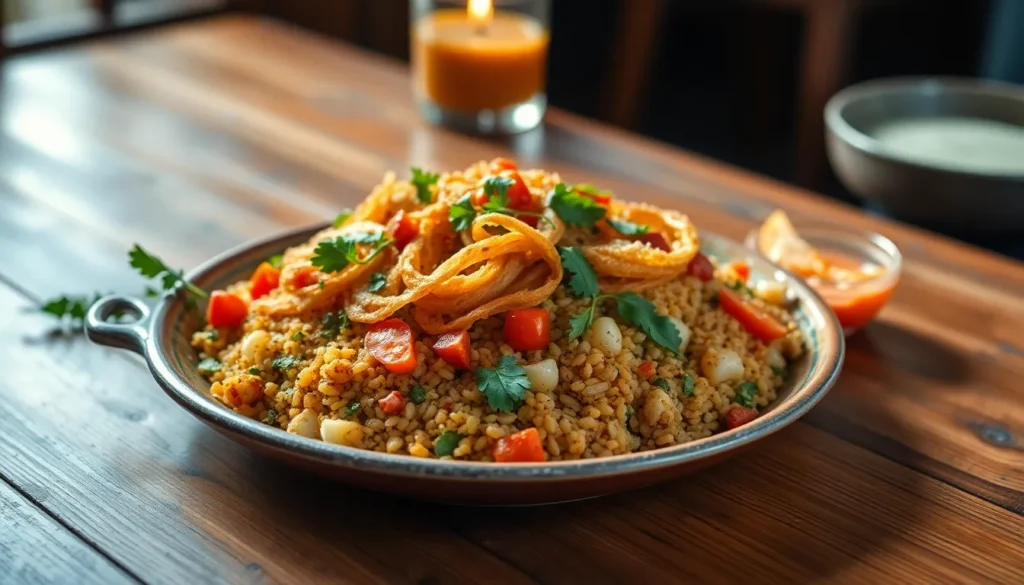Table of Contents
ToggleShropadis might sound like a quirky dance move or a new-age yoga pose, but it’s actually a delightful culinary creation that’s taking the food world by storm. Imagine biting into a dish that perfectly balances flavor and texture, leaving your taste buds doing the cha-cha. It’s not just food; it’s an experience that promises to tickle your palate and leave you craving more.
Overview of Shropadis
Shropadis represent a fusion of flavors, textures, and culinary techniques. Originating from a blending of diverse culinary traditions, they attract food enthusiasts across various demographics. This dish typically features a base of spiced grains, augmented with a variety of vegetables and proteins. Combinations often involve chickpeas, lentils, and seasonal greens, providing nutrition and vibrant color.
The preparation method incorporates slow-cooking processes that enhance flavor profiles. Chefs often layer spices, including cumin, coriander, and turmeric, to create depth in each serving. Textural contrast emerges through crispy toppings like fried onions or fresh herbs, balancing the softness of the grains and vegetables.
Interest in Shropadis continues to grow, with numerous restaurants now featuring their unique spins on this dish. Variations appear across regions, reflecting local ingredients and culinary practices. Some might include a touch of yogurt or a drizzle of tahini to enrich the flavor further.
Culinary enthusiasts find Shropadis easy to customize, making them accessible for home cooks. Dietary preferences, such as vegetarian or gluten-free, can be accommodated effortlessly. The dish serves as an excellent option for gatherings, appealing to a wide range of tastes.
Shropadis not only satisfy hungry diners but also provide a sense of community through shared culinary experiences. As people gather around this vibrant dish, conversations often spark around its rich heritage and evolving flavors. Overall, Shropadis encapsulate a delightful culinary adventure that continues to capture the hearts and palates of many.
Historical Significance

Shropadis hold significant historical importance within culinary traditions. This dish reflects a rich tapestry of cultural influences and ingredients.
Origin of Shropadis
Shropadis originated from regional cuisines, showcasing the fusion of flavors from various culinary backgrounds. Specific elements, like spiced grains and diverse vegetables, highlight traditional cooking methods. Influences from Middle Eastern and South Asian cuisines contributed to its unique characteristics. Many believe that community gatherings played a vital role in shaping the dish, emphasizing shared culinary experiences. Adaptations based on local ingredients further enhanced its appeal, creating a dish that celebrates cultural diversity.
Evolution Over Time
Shropadis have transformed as food trends and dietary preferences evolved. Over decades, chefs adjusted recipes to incorporate contemporary flavors while retaining traditional essence. Innovations in preparation techniques led to quicker cooking methods, making the dish more accessible. Seasonal ingredients influenced variations, resulting in distinct regional interpretations. The rise of plant-based diets inspired new combinations, attracting a wider audience. Shropadis now feature on menus across the globe, reflecting their adaptability and ongoing relevance in modern cuisine.
Characteristics of Shropadis
Shropadis possess distinctive attributes that enhance their culinary appeal.
Physical Attributes
Colorful presentations define Shropadis. Bright vegetables and aromatic spices create a vibrant dish that attracts attention. Textures vary, featuring a soft base of spiced grains alongside crispy toppings like fried onions. Nutritious ingredients contribute to the overall healthfulness, with proteins such as chickpeas and lentils ensuring sustenance. Additionally, seasonal greens introduce freshness, making each serving visually appealing and inviting. Variations exist, allowing for personalized adjustments while retaining core elements of the dish.
Cultural Aspects
Cultural influences play a pivotal role in the evolution of Shropadis. The dish symbolizes the fusion of Middle Eastern and South Asian culinary traditions, reflecting shared heritage and communal dining practices. Shropadis often appear at gatherings, reinforcing connections among families and friends. Unique regional adaptations showcase local ingredients, demonstrating creativity and diversity within the culinary landscape. Furthermore, Shropadis adapt to modern dietary trends, appealing to a broad audience that includes plant-based enthusiasts and health-conscious diners. Thus, they embody not just nourishment but a celebration of community and tradition.
Uses of Shropadis
Shropadis serve various culinary purposes, satisfying diverse tastes and occasions. This dish adapts to traditional and modern settings, appealing to many palates.
Traditional Uses
Traditionally, Shropadis function as a centerpiece at communal meals. Families often prepare them for special occasions, celebrating gatherings with shared flavors and textures. Customarily, spiced grains form the base, topped with seasonal vegetables and proteins like chickpeas or lentils. Often, these dishes come accompanied by flatbreads, enhancing the dining experience and encouraging sharing. Serve them at festivals or cultural events, and they evoke a sense of heritage, connecting generations through cherished recipes. These community-focused meals reinforce social bonds while introducing participants to the rich tapestry of regional cuisines.
Contemporary Applications
In contemporary cuisine, Shropadis find their place on restaurant menus across the globe. Chefs innovate by incorporating local ingredients and modern cooking techniques, appealing to health-conscious diners. Customization proves essential; vegans and omnivores alike can enjoy variations tailored to dietary preferences. Restaurants commonly offer unique toppings, such as crispy vegetables or tangy sauces, enhancing flavor profiles. Additionally, home cooks embrace Shropadis for casual gatherings, benefiting from their versatility and ease of preparation. Their presence in food trends, like plant-based diets, solidifies their status as a dynamic culinary choice, inspiring creativity in both traditional and modern adaptations.
Shropadis stand out as a vibrant and versatile addition to the culinary scene. Their rich history and cultural significance reflect a beautiful blend of flavors and traditions. As more chefs innovate and adapt this dish to local tastes, Shropadis continue to evolve while maintaining their roots.
The communal aspect of sharing Shropadis fosters connections among diners, making every meal a celebration of togetherness. With their appealing presentation and nutritional benefits, it’s clear why Shropadis are capturing the attention of food lovers everywhere. This dish not only satisfies hunger but also invites everyone to partake in a delightful culinary journey.



